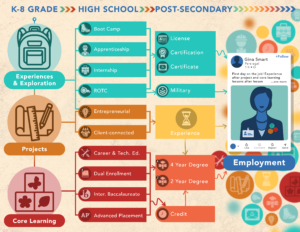The 10 Jobs of School Information

Who needs school information? What do they use it for? There are at least 10 jobs for school information:
| Stakeholder |
Job to be done |
| Parents | Choosing a school |
| Parents | Deciding where to live |
| Parents | Fulfilling education responsibility (peace of mind) |
| Community | Informed involvement and advocacy |
| Homebuyers | Deciding where to buy |
| Teachers | Employment application |
| School staff | Guide improvement |
| Policy maker | School accountability & engage parents |
| Advocates | Equitable options |
| Analysts | Achievement trends |
Realtors support parent use of school information (#2). Some businesses use school information to better support their employee families. Like parents, grandparents are also users (#3) with interest in neighborhood schools and the schools their grandchildren attend. Analysts (#10) includes grantmakers, researchers, and policy makers.
In addition to these primary stakeholders, there are analytical uses of school information including economic and employment forecasts, estimating transit needs, and, sadly, predicting prison populations.
Online services. Where do people find school information? Most start with an internet search and the first site they find in many cities in GreatSchools.
“We know from experience that it is crucial to provide school information in a way that helps parents see what the data means for their kids–that means clarity and simplicity not jargon and overwhelming amounts of data,” said Bill Jackson, CEO of GreatSchools, an online school information resource. That’s why GreatSchools ratings in a growing number of states and cities includes data about student academic progress over time, high school graduation rates, and college readiness including SAT/ACT performance and participation.
The primary audience for GreatSchools is parents but teachers use it as well. Jackson said, “We want parents, teachers and others working together to improve schools – and that’s harder if they’re not using the same data and language to evaluate and compare schools.” Using similar information helps parents, teachers, and other stakeholders get on the same page.
Report cards. All 50 states issue school report cards that include measures of achievement and high school graduation rates. Following Florida’s lead, 14 states assign or plan soon to assign A-F letter grades based on school performance which, according to the report, “are easiest for parents and other constituents to understand.” Four states include growth of the highest-achieving students in calculating school performance.
The state report cards vary widely in usefulness and accessibility. The Education Commission of the States has a useful database of state report cards. ECS recently released a review of report cards, Rating States, Grading Schools, that found parents like Delaware, DC, and Illinois while researchers like Arizona, Illinois, and Ohio. The experts were looking for student achievement and academic growth, gaps between groups, grad rates, and measures of college and career readiness.
ECS suggests that it’s a good time to reconsider whether report cards reflect state priorities and serve stakeholders. “State leaders should consider whether the public reports are providing increased transparency and serving the needs of parents and communities.
Next. Data visualizations are making it easier to convey complex information in useful way (like the Washington DC report card) with easy drill down capability for users looking for more information.
With the nearly ubiquitous access to smartphones, state leaders should consider making school information available on smartphone applications. In addition to school rating information, the apps could include:
- Learning opportunities out of school;
- College and career awareness information;
- Postsecondary guidance system including college search, decision and application support, and financial aid information, and
- Links to youth and family services.
While it may be a different app, local schools should make it easy for parents to access a student profile including progress reporting and a portfolio of personal bests. Class information and assignments should be posted to an accessible location.
With all of the stakeholders and uses of school information, it’s time to improve report cards, make them mobile, and surround them useful information.






0 Comments
Leave a Comment
Your email address will not be published. All fields are required.